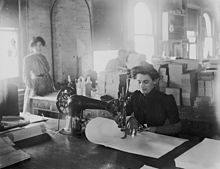Sewing
Sewing is the craft of fastening or attaching objects using stitches made with a needle and thread. Sewing is one of the oldest of the textile arts, arising in the Paleolithic era. Before the invention of spinning yarn or weaving fabric, archaeologists believe Stone Age people across Europe and Asia sewed fur and skin clothing using bone, antler, or ivory needles and "thread" made of various animal body parts including sinew, catgut, and veins. For thousands of years, all sewing was done by hand.
 |
| Sewing |
Origins
Sewing has an ancient history estimated to begin during the Paleolithic Age. Sewing was used to stitch together animal hides for clothing and for shelter. The Inuit, for example, used sinew from caribou for thread and needles made of bone; the indigenous peoples of the American Plains and Canadian Prairies used sophisticated sewing methods to assemble tipi shelters. Sewing was combined with the weaving of plant leaves in Africa to create baskets, such as those made by Zulu weavers, who used thin strips of palm leaf as "thread" to stitch wider strips of palm leaf that had been woven into a coil.
Industrial Revolution

Early 20th century sewing in Detroit, Michigan.
The Industrial Revolution shifted the production of textiles from the household to the mills. In the early decades of the Industrial Revolution, the machinery produced whole cloth. The world's first sewing machine was patented in 1790 by Thomas Saint. By the early 1840s, other early sewing machines began to appear. Barthelme Thimonnier introduced a simple sewing machine in 1841 to produce military uniforms for France's army; shortly afterward, a mob of tailors broke into Thimonnier's shop and threw the machines out of the windows, believing the machines would put them out of work. By the 1850s, Isaac Singer developed the first sewing machines that could operate quickly and accurately and surpass the productivity of a seamstress or tailor sewing by hand









No comments